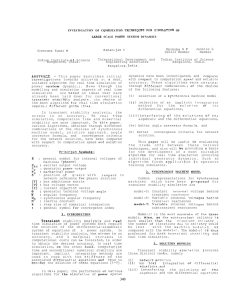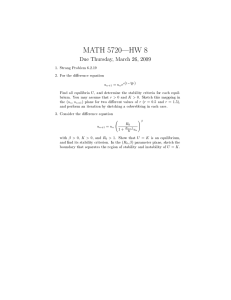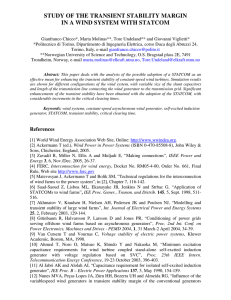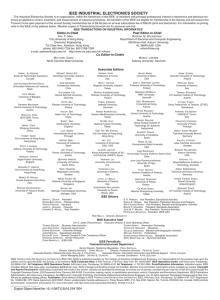T - HYCON2 Workshop on Energy
advertisement
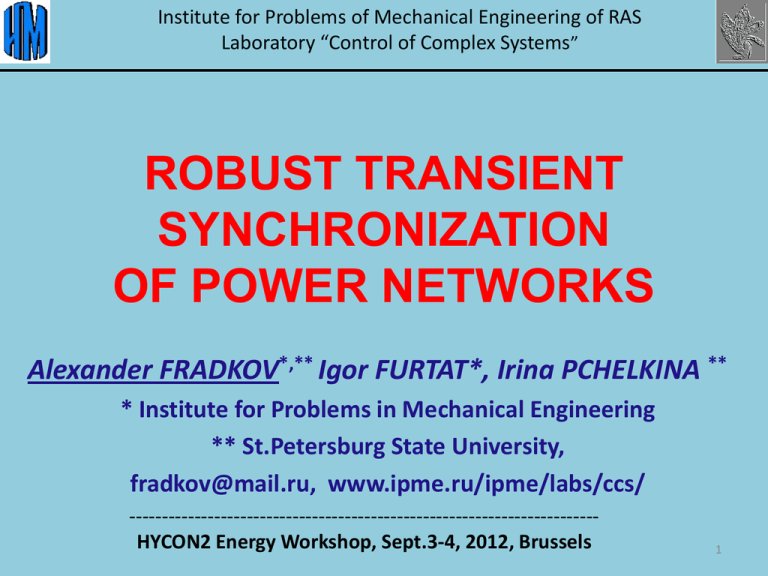
Institute for Problems of Mechanical Engineering of RAS Laboratory “Control of Complex Systems” ROBUST TRANSIENT SYNCHRONIZATION OF POWER NETWORKS Alexander FRADKOV*,** Igor FURTAT*, Irina PCHELKINA ** * Institute for Problems in Mechanical Engineering ** St.Petersburg State University, fradkov@mail.ru, www.ipme.ru/ipme/labs/ccs/ -----------------------------------------------------------------------HYCON2 Energy Workshop, Sept.3-4, 2012, Brussels 1 European Union and Russian Federation European Union area: 3236, 2 km² Russian Federation area: 17 098 246 km² Energy network of Russia More than 600 power stations with power more than 5 MW More than 10 200 transmission lines of 110 - 1150 kW Total power generation capacity 218 235.8 MW in 2011 Total generated energy: about one trillion kilowatt hours of electricity per year Emergence of ‘Smart Grid’ Development of „smart grid‟ area is caused by the following factors: - technological progress - growth of customer requirements - decreasing reliability of electrical networks - increasing demands for energy efficiency and ecological safety etc. Butler F. A call to order a regulatory perspective on the smart grid // IEEE power & energy magazine. March/April, 2009. P. 16-93. Farhangi H. The path of the smart grid // IEEE power & energy magazine. January/February, 2010. P. 18-28. Jackson J. Improving energy and smart grid program analysis with agent-based end-use forecasting models // Energy policy, 38, 2010. P. 3771-3780. Liserre M., Sauter T., Hung Y.J. Future energy systems // IEEE industrial electronics magazine, March, 2010. P. 18-37. Parks N. Energy efficiency and the smart grid // Environmental science & technology, May, 2009. P. 2999-3000. Synchronization Synchronization: - coincidence of the generator rotor speeds, - reduction to zero the difference between active electrical power and mechanical input power of each generator i i 1, ..., k i f 1 , ..., k , 1 , ..., k , Pe1 , ..., Pek , ..., Pei i - deflection of the rotor angle of the ith generator from synchronous mode i - deflection of the speed of the ith generator from synchronous mode Pei Pei Pmi Pei - the active electrical power delivered by the ith generator Pmi - the mechanical input power of the ith generator Transient stability lim Pei 0 lim i const lim i 0 t t t lim 0 t i j Willems J.L. A partial stability approach to the problem of transient power system stability // Int. J. of Control. 1974, Vol. 19. No. 1. P. 1-14. Existing results Robust decentralized control Guo G., Hill D.J., Wang Y. Robust decentralized control of a class of nonlinear systems and applications to multimachine power system stabilization // Proc. of the 36th Conf. of Decision & Control. San Diego. 1997. P. 3102–3107. Wang Y., Hill D.J., Guo G. Robust decentralized control for multimachine power systems // IEEE Trans. on Circuits and Systems-I: Fundamental theory and applications. 1998. V. 45. № 3. P. 271–279. Guo G., Hill D.J., Wang Y. Nonlinear output stabilization control for multimachine power systems // IEEE Trans. On Circuits and Systems, part 1. 2000. V. 47.№ 1. P. 46–53. G. Zhang, Y. Wang, D. J. Hill. Global Control of Multi-Machine Power Systems for Transient Stability Enhancement. IEEE Multi-conference on Systems and Control, 2007, pp. 934-939. - Network models: sets of nonlinear 3rd order differential-algebraic equations (DAE). - Measurables: rotor angles and speeds, active electrical power and mechanical power of generators. - Class of faults: short-term changes in the resistance of the transmission line (short circuits faults, etc). - Control approach: feedback linearization Qu Z., Dorsey J.F., Bond J., McCalley J.D. Application of robust control to sustained oscillation in power systems // IEEE Trans. on Circuits and Systems – I: Fundamental theory and applications. 1992. V. 39. № 6. P. 470–476. Jiang H., Dorsey J.F., Bond J. Transient and steady state decentralized control of large power systems // Proc. of the 32nd Conf. on Decision and control. San Antonio. 1993. P. 3716-3721. -The results are similar to the results of Hill et. al. - Network generator models are described by linear DAE of the third order. Existing results Barabanov A., Dib W., Lamnabhi-Lagarrigue F., Ortega R. On transient stabilization of multi-machine power systems: a “globally” convergent controller for structure-preserving models // Proc. of the 17th Word Congress, IFAC. Seoul. 2008. P. 9398–9403. Guisto A., Ortega R., Stankovic A. On transient stabilization of power systems: a power-shaping solution for structurepreserving models // Proc. of the 45th IEEE Conf. on Decision & Control. San Diego. 2006. P. 4027–4031. Ortega R., Galaz M., Astolfi A., Sun Y., Shen T. Transient stabilization of multimachine power systems with nontrivial transfer conductance // IEEE Trans. On Automatic Control. 2005. V. 50. № 1. P. 60–75. Transient stabilization of the power systems - All network parameters are known. - Network model: 3rd order DAE model for the generators; load model; the equations of transmission lines; equations of infinite buses. - Measurables: the power angles, the relative speeds, the transient electromotive force (EMF) of generators. - Control approach: energy shaping / interconnection and damping assignment (IDA-PBC) Pogromsky A.Yu., Fradkov A.L., Hill D.J. Passivity based damping of power system oscillations // Proc. of the 35th Confer. On Decision and Control. Kobe. 1996. P. 3876–3881. Synchronization of electrical generators network - Models of the generators are described by 2nd order differential equations. - The power angles and the relative speeds of each generators are available to measurement. - Control approach: passivity and speed gradient. I. Speed-gradient-energy approach Power network model i i , N 2 i Dii Pmi Gi Ei ij cos i j ij sin i j , j 1, j i Ei fi vi . (1) where i=1,..N, ij Ei E j Gij , ij Ei E j Bij , i j. i is the rotor angle, i 0 Ri ; Ri , 0 are the rotor speed and the synchronous speed, Ei is the internal voltage in the quadrature axis of the ith generator, vi is the control signal (the field excitation signal), fi Fi 1 ,, N ; E1 ,, EN – the known function, Di , Pmi , Gii , Gij , Bij – the constant parameters. Anderson P.M., Fouad A.A. Power system control and stability. Iowa: Iowa State University Press, 1977. R. Ortega et al. “Transient stabilization of multimachine power systems with nontrivial transfer conductances”/ IEEE Trans. on Automatic Control, vol. 50, no. 1, pp. 60-75, (2005). Invariant Let us neglect damping and cancel control: Di 0; Gij 0; Bij B ji ; Ei Edi (2) Pmi , (vi f i ). Gii for all i,j=1,..,N . Then the following function is an invariant of (1): N N 1 T H ( , ) ij 1 cos i j ij 1 sin i j , 2 i 1 j i 1 where (3) 1 , 2 , , N , (1 , 2 ,..., N )T . T Control goal: to achieve the desired level of (3) and approximate transient stability of (1): t t H H d , Ei Edi , i 0; , i 1,.., N . 2 (4) Control Algorithm Introduce a new control and a goal function ui vi fi , i 1,..,N , (5) N 1 1 2 2 Q H H d Ei Edi . 2 i 1 2 (6) Design control according to the speed-gradient algorithm: ui iu Q , i 1,, N . (7) i Finally the control algorithm is vi i Q Qd E B 1 cos E N j 1, j i j ij i j i i N Edi i j fi , i 1,, N . j 1 Simulation results The system (1) with N=5 and the following parameters is considered D [0; 0; 0; 0; 0]T ; P [6; 5; 5.5; 5.3; 5.8]T ; G G ii i 1 [3; 2; 2.5; 2.3; 2.8]T ; N G ij 0; Bij 4; Qd 0.6; i 2; i 2; 6. Initial conditions are as follows: / 20; / 10; / 15; / 18; / 12 ; 0;0;0;0;0 ; T T E Ed 1 0.5; Ed 2 ; Ed 3 ; Ed 4 ; Ed 5 0.9142;1.5811; 1.4832;1.5180;1.4392 . T T Simulation results II. Auxiliary loop approach DAE power network model[*] D i (t ) i (t ), i (t ) i i (t ) 0 Pei (t ) Mechanical equations i=1,…,k 1 (t ) E qi E fi (t ) Eqi (t ) Td 0i Generator electrical dynamics i=1,…,k E fi (t ) kci u fi (t ) Electrical equations i=1,…,k (t ) Eqj (t ) M ij cos i (t ) j (t ) Qei (t ) Eqi jN i 1 xdsi 2Hi (2) (t )M ij cos i (t ) j (t ) I di (t ) Eqj jN i Pei (t ) (t ) xdi xdi I di (t ) Eqi (t ) xadiI fi (t ) Eqi Vti (t ) 2Hi I qi (t ) (1) Eqi (t ) Eqj (t )M ij sin i (t ) j (t ) (3) jN i Eqj (t )M ij sin i (t ) j (t ) jN i E (t ) x I (t ) x I (t ) 2 q di di di qi 2 Assumptions 1. i(0; ) 2. , where ς is the vector of the unknown parameters of the equations (1)-(3); is known bounded set. 3. The quadratic axis currents signs Iqi(t), i = 1, …, k are known. 4. Only the rotor speed deflections i(t) , i = 1, …, k are measured. [*] Zhang G.H., Wang Y., Hill D.J. Global control of multi-machine power systems for transient stability enhancement // 16th IEEE Int. Conf. on Control Applications. Singapore. 2007. P. 934-939. Controller design The goal lim i (t ) const t T i (t ) 1 Pei (t ) 2 i (t ) j (t ) 3 i (t ) j (t ) (4) for t>T, where 1>0, 2>0, 3>0 are small numbers Control system Auxiliary loop Observer [**] Control law Qm ( p)ei (t ) u fi (t ), i 1, ..., k (5) i (t ) G0i (t ) D0 i (t ) i (t ), i (t ) Li (t ), i 1, ..., k (6) (7) u fi (t ) 1Qm ( p) i (t ), i 1, ..., k ei (t ) i (t ) j (t ) j N i [**] Atassi A.N., Khalil H.K. A separation principle for the stabilization of class of nonlinear systems // IEEE Trans. Automat. Control. 1999. V. 44. № 9. P. 1672–1687. Main theoretical result For any 0 there is a number 0 0 such that the control system (5)-(7) ensures the goal (4) for the power network (1)-(3) for 0 . Fradkov A.L., Furtat I.B. Robust control of the electrical generators network // Automation and Remote Control, 2012, submitted. Simulation results Network parameters and control system Set of the network parameters (Z) [Zhang G.H., Wang Y., Hill D.J. Global control of multimachine power systems for transient stability enhancement // 16th IEEE Int. Conf. on Control Applications. Singapore. 2007. P. 934-939] 4 H i 5,5 6 Td 0i 8 0,4 0,2 xdi 3 Di 5 1 kci 3 1,8 xdi 2,4 0,3 M ij 3 3 E fi (t ) 6 i 1, 2, 3, 4 Control system Auxiliary loop p Observer 1i (t ) 2i (t ) 4 1001i (t ) i (t ) , 2i (t ) 4 1002 1i (t ) i (t ) , 2 4 p 4 ei (t ) u fi (t ), i 1, 2, 3, 4 i 1, 2, 3, 4 Control law u fi (t ) 2i (t ) 42i (t ) 41i (t ), i 1, 2, 3, 4 Error ei (t ) i (t ) j (t ) j N i Network parameters Alarm 2) before t 10 s. M 24 M 42 0,95 p.u., when t 10 s. fault in line 2-4 Alarm 1[*]) before t 1 s., M12 M 21 0,4853 p.u., when t 1 s., M12 M 21 3 p.u., when t 1,5 s. M12 M 21 0,4853 p.u.; 0 314,159 rad/s, i (0) 0 rad/s, Pei (0) 0 p.u. [*] Genera tor Di , p.u. Hi, s. G1 G2 G3 G4 5 4 4 4,5 4 5 5 5,2 Td 0i , s. 1,7 2 2 2,1 x di , p.u. 1,863 2,17 2,01 2,07 , x di p.u. 0,257 0,32 0,28 0,35 Pm0i , p.u. 0,9 0,8 1 0,85 Vt 0i , p.u. 1 0,9 1,1 0,87 k ci , p.u. 1 1 1 1 i (0) , rad /3 11 / 36 13 / 3 7 / 20 [*] Zhang G.H., Wang Y., Hill D.J. Global control of multimachine power systems for transient stability enhancement // 16th IEEE Int. Conf. on Control Applications. Singapore. 2007. P. 934-939. Simulation results i (t ), deg wi (t ), rad/s Vti (t ), p. u. Fradkov A.L., Furtat I.B. Robust control of the electrical generators network // Automation and Remote Control. Submitted. Zhang G.H., Wang Y., Hill D.J. Global control of multimachine power systems for transient stability enhancement // 16th IEEE Int. Conf. on Control Applications. Singapore. 2007. P. 934-939.

